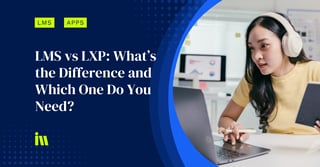LMS vs LXP: What’s the Difference and Which One Do You Need?

In the rapidly evolving world of digital learning, organizations are faced with a growing number of tools to train, develop, and engage employees. Among the most talked-about platforms are the Learning Management System (LMS) and the Learning Experience Platform (LXP). While they might seem similar at first glance, they serve distinct purposes. Understanding their differences is key to choosing the right solution for your learning strategy.
What Is an LMS?
A Learning Management System (LMS) is a centralized platform designed to manage, track, and deliver educational content. Commonly used for compliance training, onboarding, and formal learning, LMS platforms are structured and admin-driven. They enable instructors or HR departments to assign courses, monitor progress, issue certifications, and maintain training records.
Key features of an LMS include:
- Course assignment and scheduling
- Progress tracking and reporting
- Certification and compliance management
- SCORM/AICC/xAPI support
LMS platforms are ideal when there is a need for structured, consistent learning paths with clear objectives and measurable outcomes.
What is an LXP?
A Learning Experience Platform (LXP), on the other hand, is designed with the learner at the center. Think of it as the Netflix of learning—offering personalized content recommendations, social learning tools, and a more engaging, exploratory environment. Unlike the LMS, which is typically top-down, an LXP encourages a bottom-up approach, allowing users to choose learning paths based on their interests and career goals.
Key features of an LXP include:
- AI-driven content recommendations
- Integration of diverse content sources (videos, blogs, podcasts)
- Social and collaborative learning
- Personalized learning journeys
LXPs are best suited for continuous learning cultures where employees are encouraged to self-direct their growth and seek out knowledge proactively.
| Feature | LMS | LXP |
| Focus | Administrative and compliance | Learner engagement and experience |
| Content Curation | Instructor-driven | AI-assisted and user-curated |
| Learning Path | Structured and formal | Flexible and personalized |
| User Control | Limited | High |
| Social learning | Minimal | Strong |
Which One Do You Need?
The answer depends on your organization’s learning goals.
Choose an LMS if your primary need is to deliver mandatory training, ensure regulatory compliance, and track learner progress in a standardized way. It’s the backbone of structured corporate learning.
Choose an LXP if your focus is on employee engagement, talent growth, and fostering a culture of continuous learning. It works well in dynamic industries where adaptability and innovation are key.
In many cases, organizations benefit from using both platforms in tandem—leveraging the LMS for formal training while using the LXP to promote informal and self-directed learning.
Final Thoughts
The choice between an LMS and an LXP isn't necessarily binary. It’s about aligning the platform with your organization’s learning culture and strategic goals. Whether you need compliance training, continuous development, or a mix of both, understanding the differences between LMS and LXP is the first step in crafting a learning ecosystem that truly delivers.
